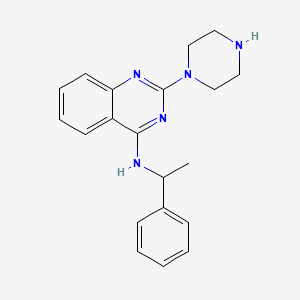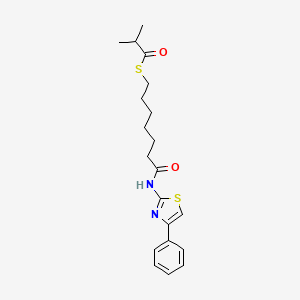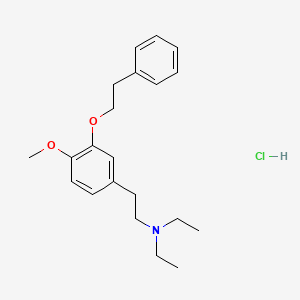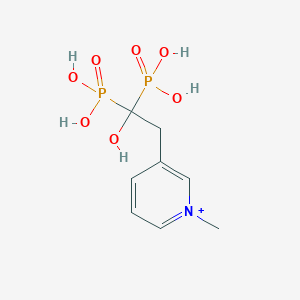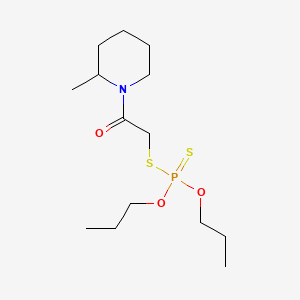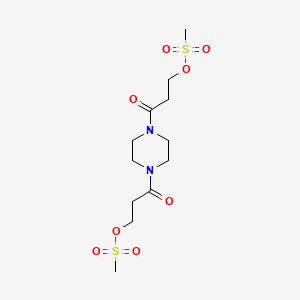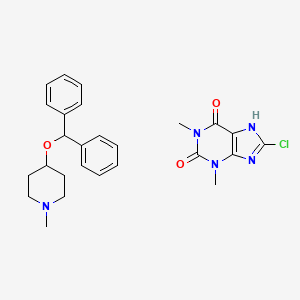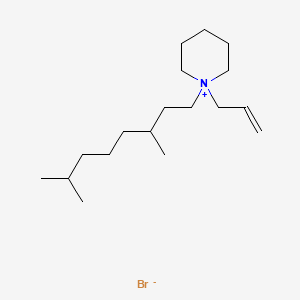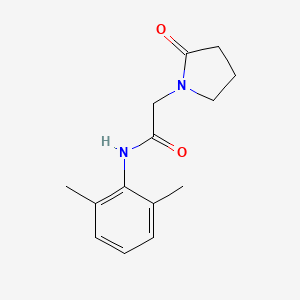
Nefiracetam
Overview
Description
Nefiracetam is a nootropic compound belonging to the racetam family. It was first developed in Tokyo in the 1990s by Daiichi Pharmaceutical. This compound is known for its cognitive-enhancing properties, including improvements in memory, mood, and motivation. It is a derivative of piracetam, with a similar chemical structure but with a phenyl group and two methyl groups added to the amine, which increases its potency compared to other racetams .
Mechanism of Action
Target of Action
Nefiracetam is a nootropic drug that primarily targets neurotransmitter systems in the brain, including the GABAergic, cholinergic, and monoaminergic neuronal systems . It also shows high affinity for the GABA A receptor .
Mode of Action
This compound modulates neurotransmission by influencing calcium channels and acetylcholine receptors . It enhances both GABAergic and cholinergic signalling . It’s also known to interact with nicotinic acetylcholine receptors , which play a crucial role in cognitive processes . This compound is presumed to be an agonist at the GABA A receptor .
Biochemical Pathways
This compound’s cytoprotective actions are mediated by enhancement of GABAergic, cholinergic, and monoaminergic neuronal systems . It modulates the GABAA receptor-channel, playing a significant role in reducing neuronal excitability throughout the nervous system . It also interacts with nicotinic acetylcholine receptors, crucial for cognitive processes .
Pharmacokinetics
It’s known that this compound is administered orally and has an elimination half-life of 3-5 hours .
Result of Action
This compound’s action results in a variety of molecular and cellular effects. It’s known for its cholinergic and gabaergic actions and modulates neurotransmission . It’s also known to enhance cognitive performance and information processing speed . Long-term usage is both neuroprotective and nootropic in research animals .
Action Environment
This suggests that improved memory-associated synaptic plasticity may be the fundamental mechanism underlying the disease-modifying action of drugs such as this compound .
Biochemical Analysis
Biochemical Properties
Nefiracetam interacts with various enzymes, proteins, and other biomolecules. It shows high affinity for the GABA A receptor, where it is presumed to be an agonist . It enhances both GABAergic and cholinergic signalling . It also exhibits antiamnesic effects against a number of memory impairing substances .
Cellular Effects
This compound has significant effects on various types of cells and cellular processes. It influences cell function by enhancing signalling of acetylcholine and glutamate at the synapse and then prolonging the calcium in the activated neuron . It also modulates the GABAA receptor-channel, playing a significant role in reducing neuronal excitability throughout the nervous system .
Molecular Mechanism
This compound exerts its effects at the molecular level through several mechanisms. It prolongs the opening of calcium channels, which enhances signalling of a receptor independent of the synapse . It also augments signalling through cholinergic receptors, which then releases most excitatory neurotransmitters from the presynaptic level .
Temporal Effects in Laboratory Settings
In laboratory settings, the effects of this compound change over time. It does not appear to significantly affect memory formation acutely, but it can increase memory formation when taken daily over a prolonged period of time . It also shows a higher rate of neurogenesis with prolonged supplementation .
Dosage Effects in Animal Models
In animal models, the effects of this compound vary with different dosages. Animal studies using acute doses tend to note most benefits in the 3-10mg/kg range . This range has been repeatedly shown to enhance memory formation when taken daily over a prolonged period of time .
Metabolic Pathways
This compound is involved in various metabolic pathways. It is extensively metabolised, and its major metabolites in humans are 5-hydroxy-nefiracetam, 4-hydroxy-nefiracetam and N-[(2,6-dimethylphenylcarbamoyl)methyl]-succinamic acid .
Preparation Methods
Synthetic Routes and Reaction Conditions: Nefiracetam can be synthesized through a multi-step process involving the reaction of 2,6-dimethylphenylamine with ethyl chloroacetate to form an intermediate, which is then cyclized to produce this compound. The reaction conditions typically involve the use of solvents such as ethanol and catalysts like sodium ethoxide .
Industrial Production Methods: Industrial production of this compound involves similar synthetic routes but on a larger scale. The process is optimized for higher yields and purity, often involving additional purification steps such as recrystallization and chromatography to ensure the final product meets pharmaceutical standards .
Chemical Reactions Analysis
Types of Reactions: Nefiracetam undergoes various chemical reactions, including:
Oxidation: this compound can be oxidized to form hydroxylated derivatives.
Reduction: Reduction reactions can convert this compound to its corresponding amine.
Substitution: this compound can undergo nucleophilic substitution reactions, where the amine group is replaced by other nucleophiles.
Common Reagents and Conditions:
Oxidation: Common oxidizing agents include potassium permanganate and hydrogen peroxide.
Reduction: Reducing agents such as lithium aluminum hydride and sodium borohydride are used.
Substitution: Nucleophiles like sodium azide and thiols are commonly employed.
Major Products Formed:
Oxidation: Hydroxylated this compound derivatives.
Reduction: Aminated this compound derivatives.
Substitution: Various substituted this compound compounds depending on the nucleophile used.
Scientific Research Applications
Nefiracetam has a wide range of scientific research applications:
Chemistry: Used as a model compound for studying racetam derivatives and their chemical properties.
Biology: Investigated for its effects on neuronal signaling and neuroprotection.
Medicine: Studied for its potential in treating cognitive impairments, Alzheimer’s disease, and post-stroke recovery.
Industry: Utilized in the development of cognitive-enhancing supplements and pharmaceuticals
Comparison with Similar Compounds
Nefiracetam is compared with other racetams such as:
Piracetam: The first racetam, known for its cognitive-enhancing effects but less potent than this compound.
Aniracetam: Similar to this compound but with additional anxiolytic properties.
Oxiracetam: Known for its stimulating effects and cognitive enhancement.
Phenylpiracetam: More potent than piracetam, with additional stimulant properties.
Pramiracetam: Highly potent, primarily used for memory enhancement
This compound stands out due to its unique combination of cognitive enhancement, neuroprotection, and mood improvement, making it a versatile compound in the racetam family.
Properties
IUPAC Name |
N-(2,6-dimethylphenyl)-2-(2-oxopyrrolidin-1-yl)acetamide | |
|---|---|---|
| Source | PubChem | |
| URL | https://pubchem.ncbi.nlm.nih.gov | |
| Description | Data deposited in or computed by PubChem | |
InChI |
InChI=1S/C14H18N2O2/c1-10-5-3-6-11(2)14(10)15-12(17)9-16-8-4-7-13(16)18/h3,5-6H,4,7-9H2,1-2H3,(H,15,17) | |
| Source | PubChem | |
| URL | https://pubchem.ncbi.nlm.nih.gov | |
| Description | Data deposited in or computed by PubChem | |
InChI Key |
NGHTXZCKLWZPGK-UHFFFAOYSA-N | |
| Source | PubChem | |
| URL | https://pubchem.ncbi.nlm.nih.gov | |
| Description | Data deposited in or computed by PubChem | |
Canonical SMILES |
CC1=C(C(=CC=C1)C)NC(=O)CN2CCCC2=O | |
| Source | PubChem | |
| URL | https://pubchem.ncbi.nlm.nih.gov | |
| Description | Data deposited in or computed by PubChem | |
Molecular Formula |
C14H18N2O2 | |
| Source | PubChem | |
| URL | https://pubchem.ncbi.nlm.nih.gov | |
| Description | Data deposited in or computed by PubChem | |
DSSTOX Substance ID |
DTXSID2020923 | |
| Record name | Nefiracetam | |
| Source | EPA DSSTox | |
| URL | https://comptox.epa.gov/dashboard/DTXSID2020923 | |
| Description | DSSTox provides a high quality public chemistry resource for supporting improved predictive toxicology. | |
Molecular Weight |
246.30 g/mol | |
| Source | PubChem | |
| URL | https://pubchem.ncbi.nlm.nih.gov | |
| Description | Data deposited in or computed by PubChem | |
CAS No. |
77191-36-7 | |
| Record name | Nefiracetam | |
| Source | CAS Common Chemistry | |
| URL | https://commonchemistry.cas.org/detail?cas_rn=77191-36-7 | |
| Description | CAS Common Chemistry is an open community resource for accessing chemical information. Nearly 500,000 chemical substances from CAS REGISTRY cover areas of community interest, including common and frequently regulated chemicals, and those relevant to high school and undergraduate chemistry classes. This chemical information, curated by our expert scientists, is provided in alignment with our mission as a division of the American Chemical Society. | |
| Explanation | The data from CAS Common Chemistry is provided under a CC-BY-NC 4.0 license, unless otherwise stated. | |
| Record name | Nefiracetam [INN] | |
| Source | ChemIDplus | |
| URL | https://pubchem.ncbi.nlm.nih.gov/substance/?source=chemidplus&sourceid=0077191367 | |
| Description | ChemIDplus is a free, web search system that provides access to the structure and nomenclature authority files used for the identification of chemical substances cited in National Library of Medicine (NLM) databases, including the TOXNET system. | |
| Record name | Nefiracetam | |
| Source | DrugBank | |
| URL | https://www.drugbank.ca/drugs/DB13082 | |
| Description | The DrugBank database is a unique bioinformatics and cheminformatics resource that combines detailed drug (i.e. chemical, pharmacological and pharmaceutical) data with comprehensive drug target (i.e. sequence, structure, and pathway) information. | |
| Explanation | Creative Common's Attribution-NonCommercial 4.0 International License (http://creativecommons.org/licenses/by-nc/4.0/legalcode) | |
| Record name | Nefiracetam | |
| Source | DTP/NCI | |
| URL | https://dtp.cancer.gov/dtpstandard/servlet/dwindex?searchtype=NSC&outputformat=html&searchlist=759830 | |
| Description | The NCI Development Therapeutics Program (DTP) provides services and resources to the academic and private-sector research communities worldwide to facilitate the discovery and development of new cancer therapeutic agents. | |
| Explanation | Unless otherwise indicated, all text within NCI products is free of copyright and may be reused without our permission. Credit the National Cancer Institute as the source. | |
| Record name | Nefiracetam | |
| Source | EPA DSSTox | |
| URL | https://comptox.epa.gov/dashboard/DTXSID2020923 | |
| Description | DSSTox provides a high quality public chemistry resource for supporting improved predictive toxicology. | |
| Record name | N-(2,6-dimethylphenyl)-2-(2-oxopyrrolidin-1-yl)acetamide | |
| Source | European Chemicals Agency (ECHA) | |
| URL | https://echa.europa.eu/information-on-chemicals | |
| Description | The European Chemicals Agency (ECHA) is an agency of the European Union which is the driving force among regulatory authorities in implementing the EU's groundbreaking chemicals legislation for the benefit of human health and the environment as well as for innovation and competitiveness. | |
| Explanation | Use of the information, documents and data from the ECHA website is subject to the terms and conditions of this Legal Notice, and subject to other binding limitations provided for under applicable law, the information, documents and data made available on the ECHA website may be reproduced, distributed and/or used, totally or in part, for non-commercial purposes provided that ECHA is acknowledged as the source: "Source: European Chemicals Agency, http://echa.europa.eu/". Such acknowledgement must be included in each copy of the material. ECHA permits and encourages organisations and individuals to create links to the ECHA website under the following cumulative conditions: Links can only be made to webpages that provide a link to the Legal Notice page. | |
| Record name | NEFIRACETAM | |
| Source | FDA Global Substance Registration System (GSRS) | |
| URL | https://gsrs.ncats.nih.gov/ginas/app/beta/substances/1JK12GX30N | |
| Description | The FDA Global Substance Registration System (GSRS) enables the efficient and accurate exchange of information on what substances are in regulated products. Instead of relying on names, which vary across regulatory domains, countries, and regions, the GSRS knowledge base makes it possible for substances to be defined by standardized, scientific descriptions. | |
| Explanation | Unless otherwise noted, the contents of the FDA website (www.fda.gov), both text and graphics, are not copyrighted. They are in the public domain and may be republished, reprinted and otherwise used freely by anyone without the need to obtain permission from FDA. Credit to the U.S. Food and Drug Administration as the source is appreciated but not required. | |
Synthesis routes and methods I
Procedure details








Synthesis routes and methods II
Procedure details







Synthesis routes and methods III
Procedure details







Retrosynthesis Analysis
AI-Powered Synthesis Planning: Our tool employs the Template_relevance Pistachio, Template_relevance Bkms_metabolic, Template_relevance Pistachio_ringbreaker, Template_relevance Reaxys, Template_relevance Reaxys_biocatalysis model, leveraging a vast database of chemical reactions to predict feasible synthetic routes.
One-Step Synthesis Focus: Specifically designed for one-step synthesis, it provides concise and direct routes for your target compounds, streamlining the synthesis process.
Accurate Predictions: Utilizing the extensive PISTACHIO, BKMS_METABOLIC, PISTACHIO_RINGBREAKER, REAXYS, REAXYS_BIOCATALYSIS database, our tool offers high-accuracy predictions, reflecting the latest in chemical research and data.
Strategy Settings
| Precursor scoring | Relevance Heuristic |
|---|---|
| Min. plausibility | 0.01 |
| Model | Template_relevance |
| Template Set | Pistachio/Bkms_metabolic/Pistachio_ringbreaker/Reaxys/Reaxys_biocatalysis |
| Top-N result to add to graph | 6 |
Feasible Synthetic Routes
Disclaimer and Information on In-Vitro Research Products
Please be aware that all articles and product information presented on BenchChem are intended solely for informational purposes. The products available for purchase on BenchChem are specifically designed for in-vitro studies, which are conducted outside of living organisms. In-vitro studies, derived from the Latin term "in glass," involve experiments performed in controlled laboratory settings using cells or tissues. It is important to note that these products are not categorized as medicines or drugs, and they have not received approval from the FDA for the prevention, treatment, or cure of any medical condition, ailment, or disease. We must emphasize that any form of bodily introduction of these products into humans or animals is strictly prohibited by law. It is essential to adhere to these guidelines to ensure compliance with legal and ethical standards in research and experimentation.



